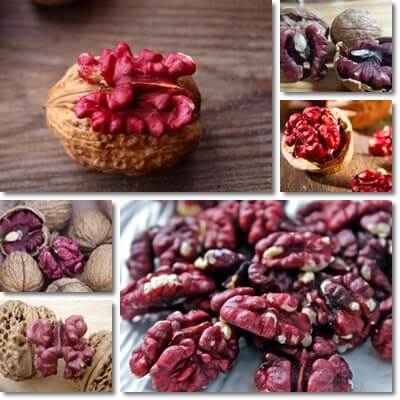Red walnuts hold similar nutritional properties to regular brown walnuts and are an exceptionally nourishing food with multiple beneficial effects for human health. Ideally, they are best consumed in limited amounts as part of a varied and balanced diet, but should be avoided by anyone with nut and walnut allergies. The most notable health benefits of red walnuts include blood sugar control and possible benefits for diabetes prevention and management, better blood cholesterol profile, minor benefits for blood pressure, improved digestion, constipation relief, benefits for hemorrhoids and better skin appearance. Given their nutritional profile, red walnuts further contribute to muscle, bone, brain and nervous system health and are especially good for pregnant women.
What are red walnuts? Red walnuts are a variety of the common walnut (Juglans regia) that initially occurred naturally in the wild. They are essentially a natural genetic mutation within the common walnut species, Juglans regia. Plants from the wild species were grafted onto selected common walnuts with brown skin with the purpose of producing a commercial red walnut variety with consistent characteristics, notably pleasant taste, larger kernel size and vibrant red kernel skin color. As a result of the efforts to propagate the species within the commercial setting, we now have a small, but thriving population that is changing our views with regards the common walnut and how it looks. See What Is a Red Walnut?

There are few studies conducted on red walnut nutrition, but researchers believe that they hold a very similar nutritional profile to regular brown walnuts, with a few exceptions.
Exception 1: Red walnuts are believed to be higher in fat which isn’t really a problem unless you eat excessive amounts or too much too often.
Exception 2: The red seed coating or kernel skin is indicative of the presence of anthocyanin antioxidants such as delphinidin and cyanidin compounds with benefits for general health.
Even with limited research, red walnuts are foreseen to boast a wonderful dietary mineral profile with exceptional amounts of the antioxidant manganese and generous amounts of iron, magnesium, phosphorus and zinc. The red variety is high in B vitamins, notably vitamins B1, B2, B5, B6 and B9 and provides smaller amounts of vitamins B3 and E, calcium and potassium.
The kernels are particularly high in fat, including polyunsaturated Omega-3 and Omega-6 fatty acids, monounsaturated fats as well as smaller amounts of saturated fat. Red walnuts are high in protein and fiber, but have an overall low sugar content and low net carbohydrate content (net refers to the carbohydrates that are neither fiber, nor sugar) which makes them good for diabetes in limited amounts.

What do red walnuts look like?
No different than the common English or Persian variety, with the exception of a vivid cherry red to purple color of the kernel skins. Red walnuts are round and slightly larger than the common English walnut. They have a light green outer husk that encloses a hard, brown shell with wrinkle-like striations. Inside the shell are the meaty kernels which, botanically speaking, are the seeds. Commercially, they are known as shelled walnuts. The kernels are covered with a thin and vivid cherry red with purple tones skin or coat (botanically a seed coat). But on the inside, they are a light cream color, just like the kernels of the common brown skin walnut.
What do red walnuts taste like?
Commercial varieties of red walnut have less tannins, which makes them delicately sweet to the taste, without the faint sharp-bitter aftertaste of walnuts with brown skin. Compared to black walnuts, red walnuts may seem quite sweet. Pleasant nutty flavors with a rich, creamy consistency may be observed in the raw kernels. The younger the kernels, the more tender, milky and nutty-sweet they are to the taste. The older the kernels, the higher the chance of them becoming rancid, especially considering the variety has a higher oil content. Shelled walnuts are more likely to become rancid faster if kept for too long or improperly packaged (exposed to air, moisture). Also see Properties and Benefits of Black Walnuts.
Nutritional properties of red walnuts and their associated health benefits
1) Good for pregnant women thanks to a high vitamin B9 (folate) content which helps prevent neural tube defects of the brain, spine and spinal cord in newborns. Their fatty acids profile, notably Omega-3 fatty acids content, contributes to normal brain and nervous system development in babies in the womb.
2) Good for diabetes. The variety is high in protein, fat and fiber which help delay stomach emptying and digestion and slow down the absorption of sugar into the bloodstream. This helps prevent blood sugar spikes and may provide benefits for insulin sensitivity. What makes red walnuts good for diabetes and blood sugar control is their low sugar content (despite the slightly sweet taste) and low net carbohydrates content (net meaning the carbohydrates without counting the fiber and sugars).
When consumed in limited amounts as part of an overall clean, varied and balanced diet, they are a wonderful addition to a diabetic diet. Also see Black Walnuts and Diabetes.
Even better, most of the available kernels are certified organic red walnuts. Fortunately, walnuts in general are relatively clean and thus safe to eat as the walnut tree does not require as much treatment against insects or other pests compared to other food products.
3) Relieve constipation and help with hemorrhoids. Like most nuts and seeds, red walnuts are high in fiber and fat, both of which give bulk to stools and ease their passing through the digestive tract, helping relieve constipation naturally and achieve regular, healthy stools that are easy to pass. Because they help improve the digestion process they way they do, they are also a good food to eat if you have hemorrhoids.
4) Benefits for cholesterol and blood pressure. Eating small amounts of walnuts in general provides a variety of healthy fats (Omega-3, Omega-6) and helps improve blood cholesterol profile over time, contributing to higher HDL (good) cholesterol and lower LDL (bad) cholesterol levels. Furthermore, the magnesium and potassium in the kernels hold benefits for hypertension, helping lower blood pressure. Vitamin B6 further provides benefits for cardiovascular health. But intake must be limited to small amounts because the kernels are still high in fat, calories and a source of saturated fat.
5) Benefits for skin. The overall high fat content and healthy fat profile (high polyunsaturated fatty acids, good monounsaturated fatty acids and low saturated fat) as well as good vitamin E and B vitamins content exert a nourishing action on the skin and provide antioxidant benefits with anti-aging effects. The fats and vitamin E in particular protect against skin damage, help repair existing damage and improve skin aspect. Zinc may hold anti-acne benefits, while B vitamins prevent dry skin and various skin disorders.
6) Food for the brain. The association between walnuts looking like a human brain and also being good for the brain is true. All the fats in the kernels contribute to brain nourishment and support intellectual effort. Omega-3 fatty acids in particular are physically part of the brain as well as help with memory and learning. In babies in the womb, Omega-3 are responsible for brain and nervous system development, while in infants, they help develop cognitive abilities. Furthermore, the amino acids that make up the protein in red and other walnuts help synthesize neurotransmitters for the brain and regulate thinking, appetite, sleeping and other aspects of our daily life.
7) Boost immunity. All foods high in protein are crucial for a strong immune system. Protein is used by the immune system to make antibodies and actively participate to immune system reactions that seek to stop infections and prevent disease.
8) Builds and repairs damaged muscle. Red walnuts are a great high-protein food to eat if you are looking to gain muscle. The amino acids in the protein help build and repair damaged muscle fibers and contribute to better muscle tone. Also a good source of iron, red walnuts then help oxygenize and activate the muscles for improved strength. The rest of the B vitamins have a tonic, energizing effect.
9) Good for strong bones. Rich in phosphorus and magnesium and a modest source of calcium, red walnuts are a great food to eat for better bone health and osteoporosis prevention as they help increase bone mass. Both phosphorus and magnesium direct the absorption of calcium into bones and good calcium absorption is dependent on a sufficient intake of the other two minerals.
Side effects and contraindications
What makes red walnuts bad for you is either an excessive intake or an existing allergic reaction.
1) An excessive intake causes fats to accumulate and this can result in weight gain and complications, including diabetes, high blood pressure, high cholesterol, atherosclerosis (plaques on the inside of artery walls), mobility problems, endocrine problems etc. The side effects of weight gain are more serious when there is an existing metabolic disorder such as diabetes.
2) An existing allergy to walnuts or multiple nut allergy are clear contraindications of walnut consumption. Food allergies can have severe consequences and result in anaphylactic shock which is why avoidance of food allergens in all forms is strongly advised.
